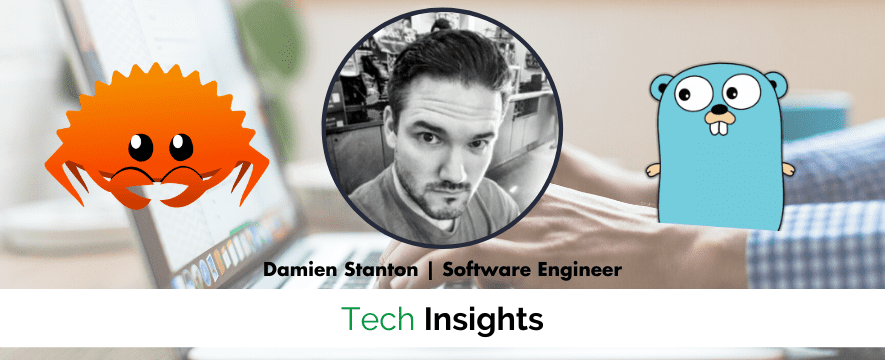This post comes from Coach Erika. In this post, she shares a step-by-step guide for passing your first-round interview. For more, follow Coach Erika on LinkedIn, Twitter, and check out her newsletter, The Career Whispers.
Today I’m going to teach you how to pass any first-round interview in tech, even in a difficult talent market.
I’ve coached over 200 people in tech job searches (from APMs to eng managers to chief product officers, and everything in between). 93% percent of them landed jobs at Google, Meta, Uber, Airbnb, Stripe, or a similar top-tier tech company—without burning themselves to the ground endlessly preparing, or winging it and hoping for the best.
I’m not a recruiter or HR leader. I’m an engineer and product manager, like many of you. In 2013, I landed my first job in Big Tech (at Google), and my career took off. Over the next 10 years, I moved into management and leadership roles, where I learned about how the sausage is made when it comes to interviews, offers, and talent assessments. Now, I’m a chief product officer, and I moonlight as a career coach to help people unlock outsized career opportunities.
My goal in sharing this Minimum Viable Interview Prep (MVIP) process is to arm you with the employer and interviewer perspective so that you can build confidence in your job search. I’m passionate about helping people with job searching because I know how much the right role can set you up for success in your career and financial life.
Why Employers Do First-Round Interviews
First rounds are designed to filter out candidates who are unlikely to be a contender for an offer.
Interviews are very expensive for employers (time, coordination, resources, opportunity cost). The singular goal of a first-round interview (from the employer’s perspective) is to determine if they want to invest in additional interviews with that candidate.
How First-Round Interviews Fit in the Broader Interview Process
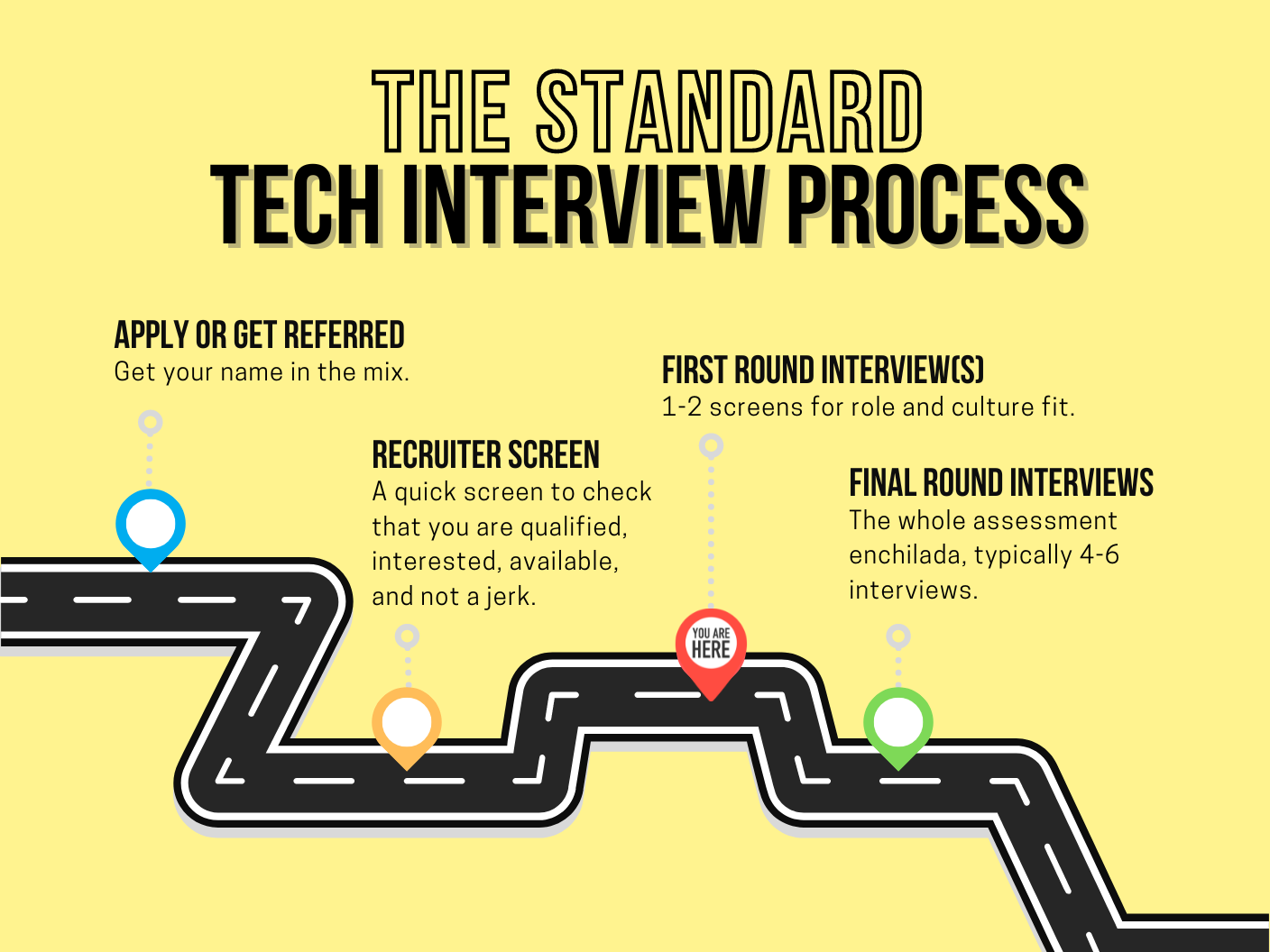
By the time you get to a first-round interview, you likely have already:
- Applied or been referred by an employee
- Spoken to a recruiter or HR representative (phone screen)
If you pass a first-round interview, the next step is often second rounds (another single interview), or even final-round interviews (three to six interviews back-to-back in one day or split over two days).
The Logistics
Most first-round interviews in tech are:
- 30 minutes to 1 hour
- on the phone or via video chat
- with just one interviewer (not panel-style)
- conducted by a hiring manager, peer, or another person familiar with the role
The standard time breakdown is typically:
- 10% intro
- 70% questions from the interviewer
- 20% questions from the candidate
For a 45-minute interview, this looks like:
- 3-5 minutes intros
- 35 minutes questions from the interviewer
- 5-7 minutes questions from the candidate
Most first-round interviews stick to behavioral questions, i.e. questions that ask you about your own experiences, like “Tell me about a time when you had a conflict with a colleague.”
Generally, the first-round interview scope isn’t comprehensive. Employers aren’t going to be able to fully assess your fit for the role/team/company in less than 60 minutes!
Note: It’s a bit of a hot take, but I advise people to run if a company gives you an offer at this stage. (Just imagine how undiscerning they will have been with your future peers as well!)
On-the-spot offers in tech are rare, but all of us who build products know that systems fail at the edge cases—few of you will get an offer in your first or second interview (and this is a good thing), but my advice is to walk away (or at least ask a lot of questions) if you get an offer on the spot.
Common first-round interview question themes:
- Your resume and online content (including expertise posts and thought leadership)
- 1-2 core competencies for the role (usually the P0s, not the P2s and P3s)
- Culture fit (these can be direct questions, e.g. “Describe your ideal team culture,” or indirect assessments based on your behavior, mannerisms, or speech: what you say and how you say it)
Special cases
Are you a software engineer or data scientist? Your first-round interview will likely be a technical screen (coding or system design or experimental design). Note that the way you problem-solve and communicate are assessed, not just whether you arrive at a working solution!
Are you a PM? Your first-round interview will likely focus more on product design, product sense/execution, and data analysis or estimation questions (PM core competencies).
How to Prepare
It’s time to talk about tactics for interview preparation.
Now is a good time to introduce Minimum Viable Interview Prep (MVIP). Below is a quick summary of the approach, with links to dive deeper before your next interview.
The How, Part 1: Get Your (Career) Story Straight
Know your digital footprint
Anything and everything on the open web is fair game for an employer or interviewer to read and bring up in your interviews. This includes LinkedIn posts, Medium or Substack articles, GitHub, tweets, old blog posts, quotes in newspaper articles, etc.
A useful to-do list:
- Know what’s out there (about you or authored by you)
- Assess whether it fits how you’d like to present yourself
- Modify as needed to represent yourself as you’d prefer
For example: If I were looking for a data science role, I’d want to spend a few hours organizing the Python code in my public machine learning GitHub repo. It was written under timeline duress (!) and needs some refactoring so I can put my best foot forward if someone skims the code.
Know your (strategic and compelling) reasons for wanting this role
When you go for an interview, you should assume the company is assessing at least two to four other people for the role. Like any competition, you want to get out front quickly and take the lead. One way to do this is to be clear and concise about why you want this job.
Generally, avoid reasons that revolve around work hygiene or professional conveniences, e.g. compensation, short commute, remote work. This advice may seem obvious, but yes, people bring these up often. Don’t be one of them.
Avoid reasons that sound like complaints about your current or past employer, e.g. “better company,” “smarter colleagues,” “kinder boss,” “escaping a toxic culture.”
Stick to reasons that:
- convey what you bring to the role (the compelling ones for the employer)
- explain how this role will accelerate your career (the strategic reasons)
You don’t need 10 reasons. One single, decisive reason will do: “I’ve spent eight years building large-scale, distributed systems for products used by about 100 million users. An exciting and progressive step for me would be to build similar technologies for the billion-user scale.”
Know the role (map it)
One of the oldest sales tricks in the book is a tactic called “mirroring.” It’s a psychological concept that involves physically and verbally doing what the other person is doing. People are comfortable with their own mannerisms. When you mirror them, you make them comfortable and subconsciously make them feel you are like them.
You can use mirroring in your interview process. How? Use their language when describing your experiences.
How to do this (interview pre-work)
- Paste the job description into a doc, then highlight keywords and concepts.
- Put the keywords into a table (one row per keyword or concept). Then add a column to the right. Here’s a template to get you started.
- In the right column, write down parts of your experience that map to that concept.
- Read this before your interview.
- In the interview, when you talk about your experience (right column), use their language (left column) to explain what you did.
Example:
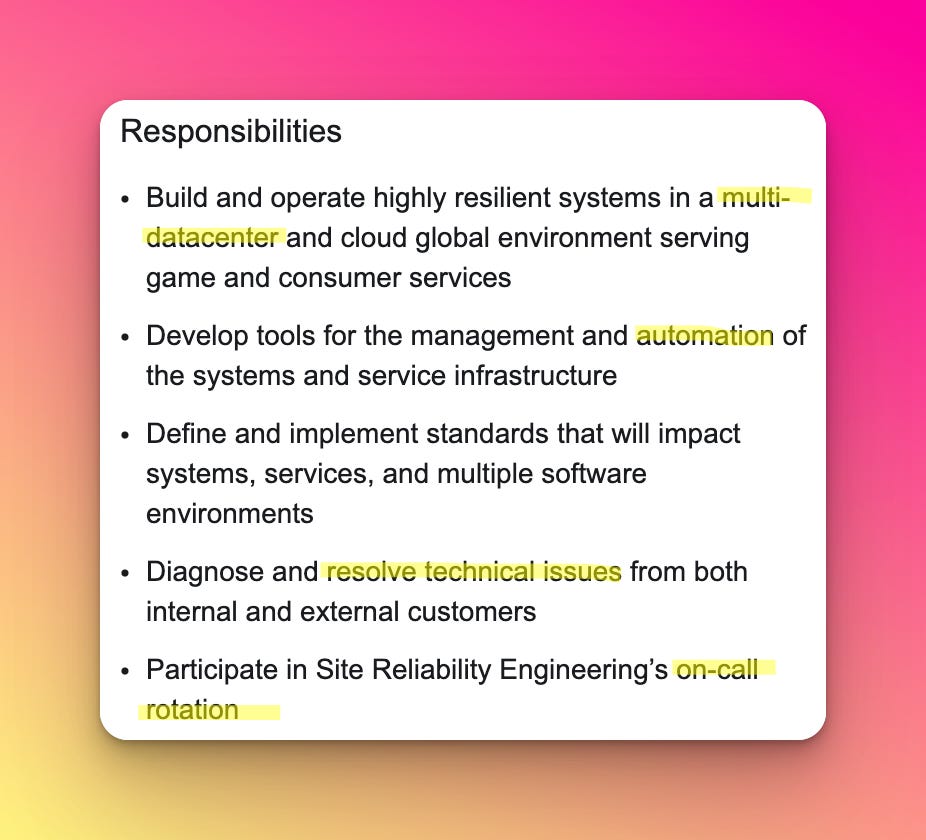
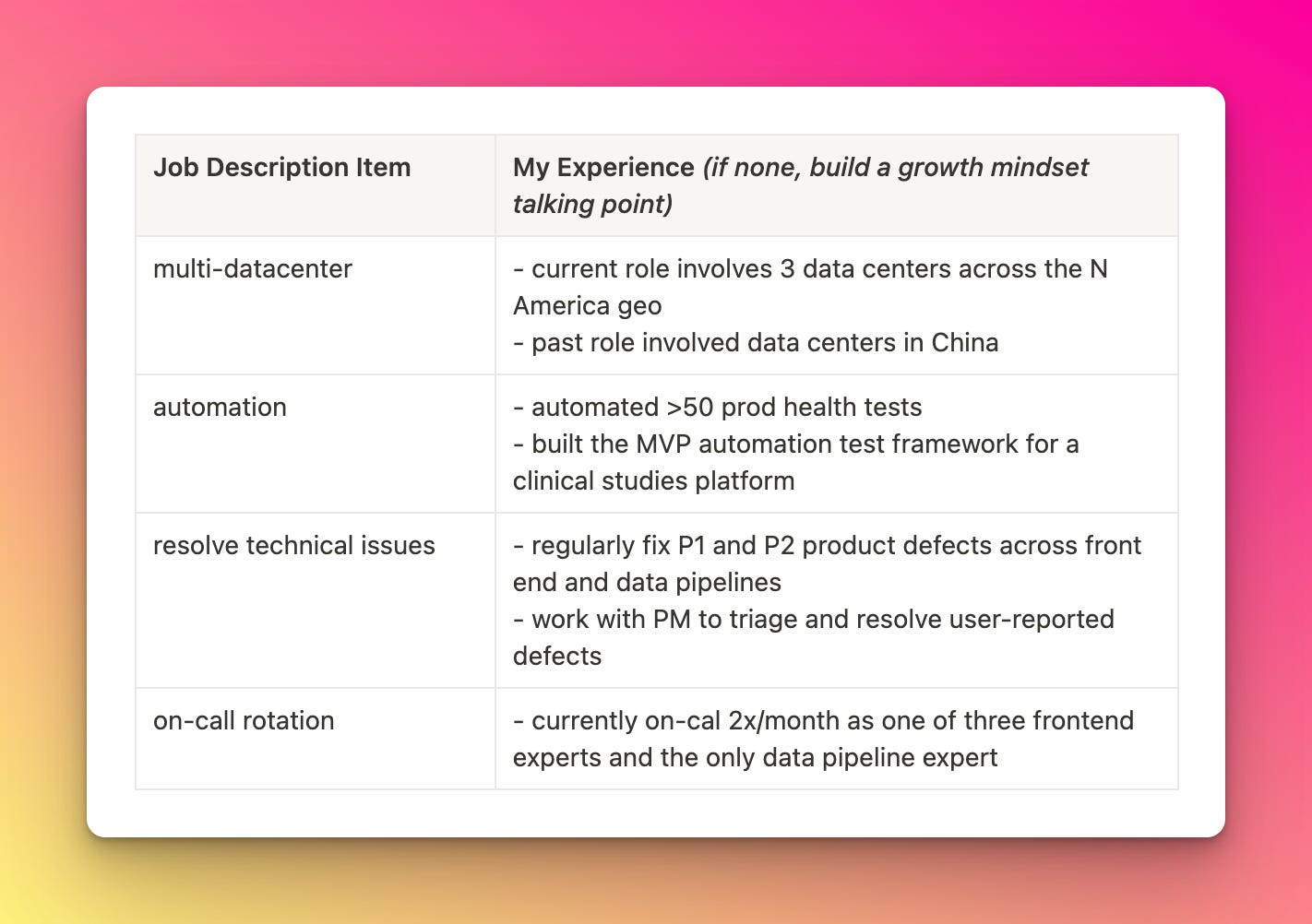
In the interview, use their language when you describe your experiences: “When I was on-call for a multi-datacenter system, I diagnosed and resolved a major technical issue and ensured services were restored. Later, I wrote automation to programmatically detect this type of issue in the future.”
The more familiar the interviewer is with the job description and the role requirements, the more effective this technique will be (at subconsciously reinforcing your fit for the role).
The How, Part 2: Walk Down Memory Lane
The vast majority of interview questions will ask you to dive into your past experiences and describe how you handled a specific situation. When you’ve been working for five or more years, it can be really tough to index your memory and pull out the perfect example on a dime.
(By the way: It’s not you. It’s everyone. We all struggle with this. It’s a neurobiological limitation with the way our brains store memories.)
Writing down the answers to hundreds of behavioral questions is a common way I see candidates try to remember all the things they’ve accomplished. This is exhausting and can actually overload your brain and cause you to freeze up or even “blackout” in an interview.
To avoid burnout and get better results, I instead coach candidates to pick three to five recent major projects in their careers, and then remember every single detail they can recall about those projects, for example:
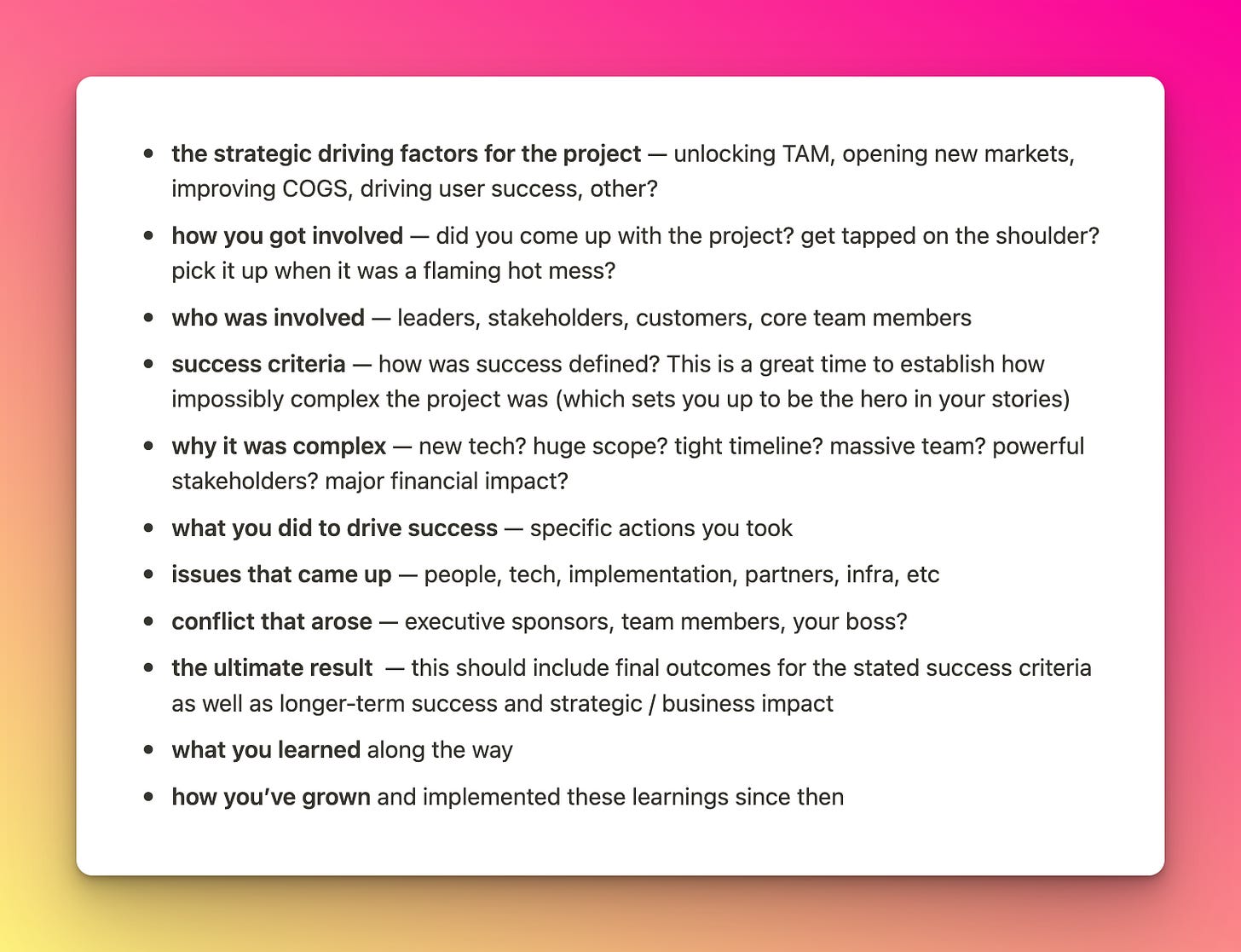
Writing all of this down will help you reference the details before future interviews (especially if you have an extended job search, as is common in difficult talent markets like the one we’re experiencing this year).
When you are asked about past work experiences, your brain will more easily pull from one of these projects. And you’ll be able to provide high-resolution details on the context, what happened, and the results (quantified!).
What counts as major?
Large and complex, ideally.
- Large in scope (important to the business, strategic, involves lots of stakeholders, significant revenue or user impact)
- Complex (in terms of the stakeholders, core team, tech, timeline, resources, etc.)
Why large and complex?
Demonstrating your maximum capacity will enable you to validate your ability to handle larger scope and responsibilities, which typically correspond to higher titles and compensation (if that matters to you).
What counts as recent?
Ideally the past two to four years. The two-to-four-year guideline is largely pragmatic. Memories aren’t stable, and they do experience neural “bit rot”—which means even if you resurrect those memories, it’ll be hard to recall the details.
A second reason to aim for recent projects: Assuming your career has been growing, recent projects will likely also be larger and more significant (see: Why large and complex?).
The How, Part 3: Learn the Behavioral Frameworks, and Never Again Sweat an Interview Question
Most people know that interviews are chock-full of behavioral questions, and most candidates either know (or quickly research) the STAR method during their interview prep.
A refresher on the STAR method if you’re unfamiliar or haven’t interviewed recently:
- S: Situation—what was happening at the time (context)
- T: Tasks—what you were responsible for
- A: Action—what you did to solve the problem and deliver outcomes
- R: Result—the impact of your actions
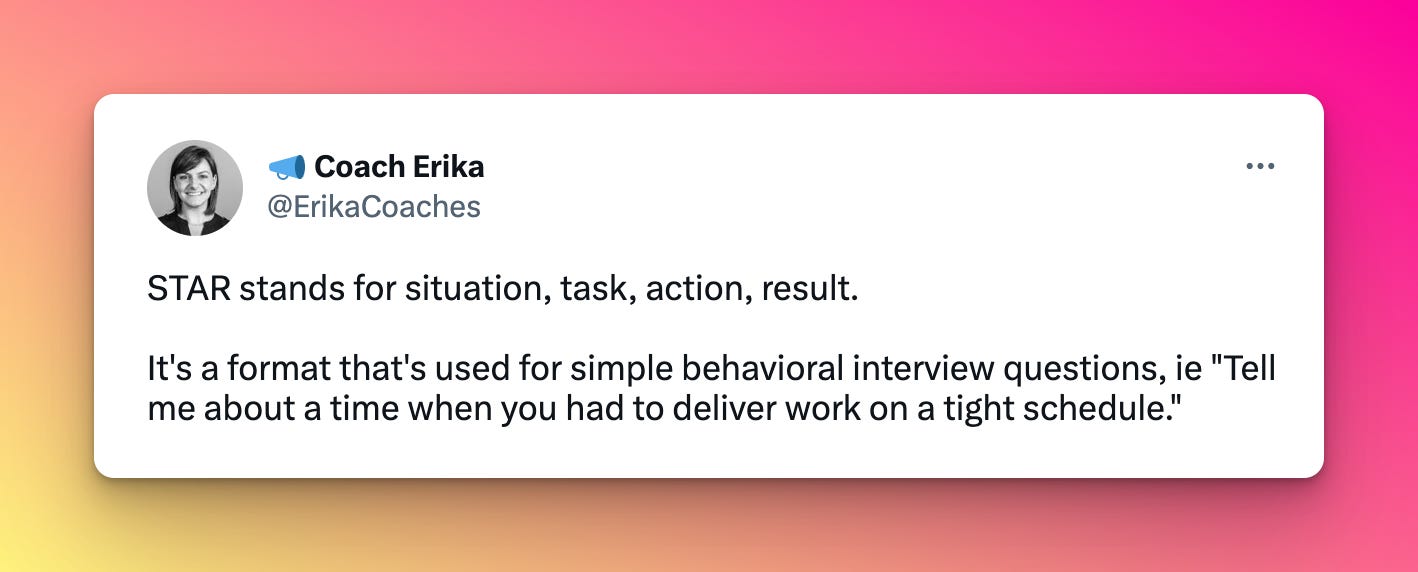
Simple, right? Yet there’s more to it…
Behavioral interview questions were invented 50 years ago, in the 1970s. Studies quickly found that these questions were 55% more effective at predicting on-the-job performance than the prevailing interview questions at the time. They took the business world by storm and became the de facto interview technique. Today, they are used extensively in tech interviews (by my estimate, more than 60% of interview questions are behavioral). Amazon actually sends candidates a STAR primer before their interviews!
But it’s been half a century, and behavioral question formats have evolved. Your approach to answering them needs to evolve too.
In tech, I see 3 main formats for behavioral questions:
- Pure — “Tell me about a time when…”
- Situational — “Put yourself in this situation; what would you do?”
- Theoretical — “What’s your general approach to doing X?”
All of them ask what you have done or what you would do (in a situation) or what you generally do, to extrapolate and predict on-the-job performance. To interview effectively in tech today, you need to know how to answer each of these questions.
Below is a primer you can use to answer each type of behavioral interview question.
Pure (70% of Behavioral Questions)
- Why they ask: Understanding how you’ve behaved in the past can be used to extrapolate how you might perform in this role
- What they ask: Share a specific career experience from the past
- How to respond: Start with STAR, then add two improvements. First, what you learned. Then, how you evolved your approach and incorporated these learnings in a future situation. (I call this STAR++)
Example: Tell me about a time you had to work quickly to deliver a result.
S: Start with context (strategic, business, project)
Answer: Situation
“I was at a pre-IPO company in an eng leadership role. To prep for the IPO, we needed to update compensation bands and ensure all 250 engineers were being paid fairly.
This was complex, because comp is a charged issue and I only had six weeks to deliver.”
T: Explain your role in the situation
Answer: Tasks
“The project was driven by HR. They were doing the analysis and proposing the new comp bands.
My job was to test the new comp bands against the current comp for every engineer in the company and ensure that the new comp bands were both equitable and attractive for current and future talent.”
A: Share the actions you took to ensure success
Answer: Actions
“As HR pushed new draft engineering comp bands:
- I analyzed them against the career ladder to detect issues
- I verified that no employee would have a compensation regression
- I identified and corrected errors
- I messaged the comp changes to the 250-person eng team”
R: Quantify the results (from a short- and longer-term strategic perspective)
Answer: Results
“I rolled out the engineering comp bands on time.
- Engineers were happy with the changes (no comp regressions, most got pay increases)
- Finance could accurately forecast headcount spending with the new comp
- Comp was ready for IPO”
Then add the growth mindset (the ++ in STAR++)
+ (learnings): Expose what you learned
Answer: + (learnings)
“There was an uncaught error in the Sr. Mgr comp bands that resulted in above-market comp for some employees.
The project goal just set a minimum, no maximum, so I didn’t look for outliers. I learned to ask for success criteria in a range, not just the target!”
+ (future improvements): Share how you’ve adapted your approach for future projects (given the learnings)
Answer: + (future improvements)
“I recently ran a project to reduce our platform web page load times. Initially the executive sponsor set the success criteria as loading in less than 1 second. I inquired about the success criteria as a range and was able to set a clearer target: 0.3 to 1 second.
Setting the success criteria as a range saved us from major misalignment that would have doubled the development efforts and led to exorbitant ongoing server costs.”
Try this at home! (with these handy practice questions):
- “Tell me about a time when you failed.”
- “Walk me through an experience where you had to give difficult feedback.”
- “Share an example of an excellent team culture that you were part of.”
Tip: If you’re in a time pinch, focus your prep time on pure behavioral questions (70% of all behavioral questions).
Theoretical (20% of Behavioral Questions)
Why they ask: Learning how you generally go about doing tasks or activities that are central to the role
What they ask: Your general approach to a core element of the role and your craft
How to respond:
- Outline your general approach (3-5 elements)
- Describe your approach for each in detail
- End with an example (use STAR) that exemplifies your use of this framework
Example: How do you give feedback (as a manager)?
Answer, part 1: Outline your general approach (3-5 elements)
Three major considerations:
- Behavior — what specific behavior am I trying to change?
- Messaging — how can I give the feedback in the way it will be most effectively heard, understood, and actioned?
- Alignment — how can I ensure that me and the team member are in agreement with the need to change, how we’re going to measure success, and how we’ll check in to monitor the change?
Answer, part 2: Describe your approach for each in detail (with tactics)
For each of these major considerations, here’s how I would specifically go about doing this:
- Behavior
- What is the specific behavior that needs to change?
- What are the impacts of that behavior (on the individual, team, project, product, business, or company strategy)?
- If this specific behavior changes, what will improve (for the individual, team, project, product, business)?
- Messaging
- Direct
- What do I need them to hear?
- What words must be said?
- How will I know if they understand the message?
- Empathetic
- How can I respect the vulnerability of the situation?
- What do I need them to not hear? (avoid creating defensive behavior)
- What words should I avoid?
- Alignment
- What questions can I ask to ensure they understood?
- What questions can I ask to ensure we’re aligned on the problem and what needs to change?
- What questions can I ask to collaborate on a definition of what success looks like so we know if the feedback is being actioned?
- Create a check-in plan (activities, frequency)”
Answer, part 3: End with an example (use STAR) that exemplifies your use of this framework
Situational Context and Tasks:
“At Google, I managed a team of technical program managers (TPMs) who owned critical, strategic programs for the organization. One of the TPMs on the team was chatty and often made other team members late to meetings or distracted with their work. Their intent was to build relationships at work, but the reality was that other team members got distracted, anxious, and even stressed by my team member’s chattiness.”
Actions:
“I came up with a plan, first by clearly identifying the behavior that needed to change. Because the problem was caused by a personality trait, it was important to isolate the specific problem being caused and the specific action that needed to change. In this case, it was having personal chats with colleagues during core work hours.
Next, I needed to plan the messaging, to avoid making the person feel attacked or defensive. I decided to express the problem in terms of how it impacted both their project success and their teammate’s stress levels. Then, I planned some alignment questions to ensure we were in agreement on the problem, the change that needed to happen, and how we were going to hold ourselves accountable to measure success and check in.
Then, I had the conversation with the team member.”
Results:
“The team member immediately acknowledged the issue, since they knew themselves to be chatty, and thanked me for bringing the impacts (to others) to their attention. We aligned quickly on a plan to check in monthly, and the team member agreed to let me periodically probe the team to ensure that the change was taking place.
Within two months, the issue was resolved. Team members felt less stressed, more focused, and more confident in the team dynamics. My team member continued to connect with colleagues at lunch and after work hours, to build meaningful relationships (which was their personality). Today, that team member is a successful TPM leader at Google and thanked me for helping them see this blindspot.”
Try this at home! (with these handy practice questions):
- “What’s your general approach to building respectful, delightful products?”
- “How do you go about building team culture?”
- “How do you give feedback?”
Situational (10% of behavioral questions)
Why they ask: To see how you gather and synthesize information to create a reasonable path forward using strong judgment
What they ask: In a hypothetical (but realistic) work situation, tell me what you’d do
How to respond:
- Ask clarifying questions to fully understand the situation (enough that you can create an action plan)
- State any assumptions you’re making
- Outline a plan, then expand with specific details on your approach
- Check in with the interviewer to see if you missed anything or if they want to dive deeper into a given area
- Summarize
Example: You found out the project you are leading is being canceled. What do you do?
Answer, part 1: Ask clarifying questions
Some clarifying questions (and answers from interviewer):
- what stage of completion is the project (beginning / middle / end)? (end)
- how long has the team been working on this? (a while)
- how important is this project to the team (strategic priority)? (it’s the only work that the team has on its plate)
- how many people are working on this? (30)
- any users / clients / customers affected? (no)
- other internal teams affected? (yes)
Answer, part 2: State your assumptions
I’m going to assume:
- there’s an open dialogue with the leadership team
- there are data available to confirm the validity of this decision
- the team doesn’t know yet
- the team is not going to be fired, laid off, or otherwise disbanded (thus will be available to work on other high priority efforts)
Answer, part 3: Outline a plan, then expand (3-5 items)
Three major considerations:
- Trust but Validate the Decision (before communicating further)
- Meet with exec leaders
- Ask about assumptions
- (if I don’t agree with the conclusion, gather data, and present it back with alternative solutions)
- (if agreed on the conclusion, move forward)
- Team (communication, landing the change, setting the team up for future success)
- make a wind-down plan
- communication plan — crisp, clear, direct, state assumptions, preemptively address likely FAQs
- announce to everyone at once, in person
- make information available in written, transparent, discoverable format
- address individual concerns, leverage managers (align with them)
- develop a future plan for the team (replace the strategy void)
- Internal customers (communication, partnering to problem solve & land the change)
- communication plan — crisp, clear, direct, state assumptions, preemptively address likely FAQs
- announce in person with each internal customer
- make information available in written, transparent, discoverable format, add FAQs as they come in
- partner to problem-solve and ensure they land on their feet.
Answer, part 4: Check back with the interviewer
“Did I miss any key steps from your perspective, or is there any area you’d like to dive into together?”
Answer, part 5: Summarize the question prompt and key items
“You asked me what I would do if I found out that a project that I was leading was canceled. I walked you through my process of validating the decision, then creating a plan, communicating to both the team working on the project and the internal customers of the project, then my goal to land the wind-down effort in a timely and effective manner, and ensure the future direction and productivity of the team.”
Try this at home! (with these handy practice questions):
- “You just started on a new team. Tell me your approach to ramping up.”
- “You just found out the project you are leading is being canceled. What do you do?”
- “You get a report that your product is crashing. What do you do?”
Want more examples? Check out the reference posts at the end for detailed walk-throughs for each of these behavioral question types.
The How, Part 4: Formulate High-Signal Questions (to get interviewers thinking)
If you’re a running fan, you know that the Boston Marathon is often won or lost at one single point in the race—Heartbreak Hill—including in this year’s marathon.

The Boston Marathon’s Heartbreak Hill is so tough that neighbors at the top of the hill marked it with this wooden sculpture.
Interviews are often won or lost by the questions you ask the interviewer at the end. Half of the battle is preparing well and showing up to answer the interviewer’s questions; the other half is asking them questions that get them thinking (and make you stand out).
We all want to work with exceptional colleagues who work hard, get things done, and push us to greater heights. Interviewers are exactly the same. You need to get them thinking (in a good way).
Formulate questions that are interesting and thoughtful, and you’ll end the interview on a high note and possibly put yourself in the lead.
3 steps to formulating great questions for interviewers:
- Define the signals you need (to determine if you want the role). Bring questions whose answers are actually important to you. Anyone can grab a question from a listicle. Only you can ask questions that will answer your open questions about the role.
- Do your research. On the industry, company, competitive landscape, team/product, and even the interviewers. Look for trends, competitive landscape changes, and news. You can find these on consulting firm dossiers, VC thought-leadership white papers, the company’s website, Yahoo Finance, and competitive landscape engines like G2 and Capterra.
- Formulate questions that highlight that you’ve done your homework and that give you the signal you want.
You can do this in an hour or two, and it’s well worth the investment. You can even reuse some of these “first-round” questions in later interviews to get diverse perspectives from the full panel.
An example of a high-signal question that one of my coaching clients formulated for an interview at Cruise, a self-driving car company:
In your three years at Cruise, the privacy world has expanded, with the CCPA and other states discussing more regulations for consumer privacy—how has this impacted the nature of your work, and what do you see as the biggest challenge or area of focus as Cruise continues to expand to new geos?

Voilà! You’re ready for your next interview.
Here’s a recap checklist you can use for your next first-round interview prep:
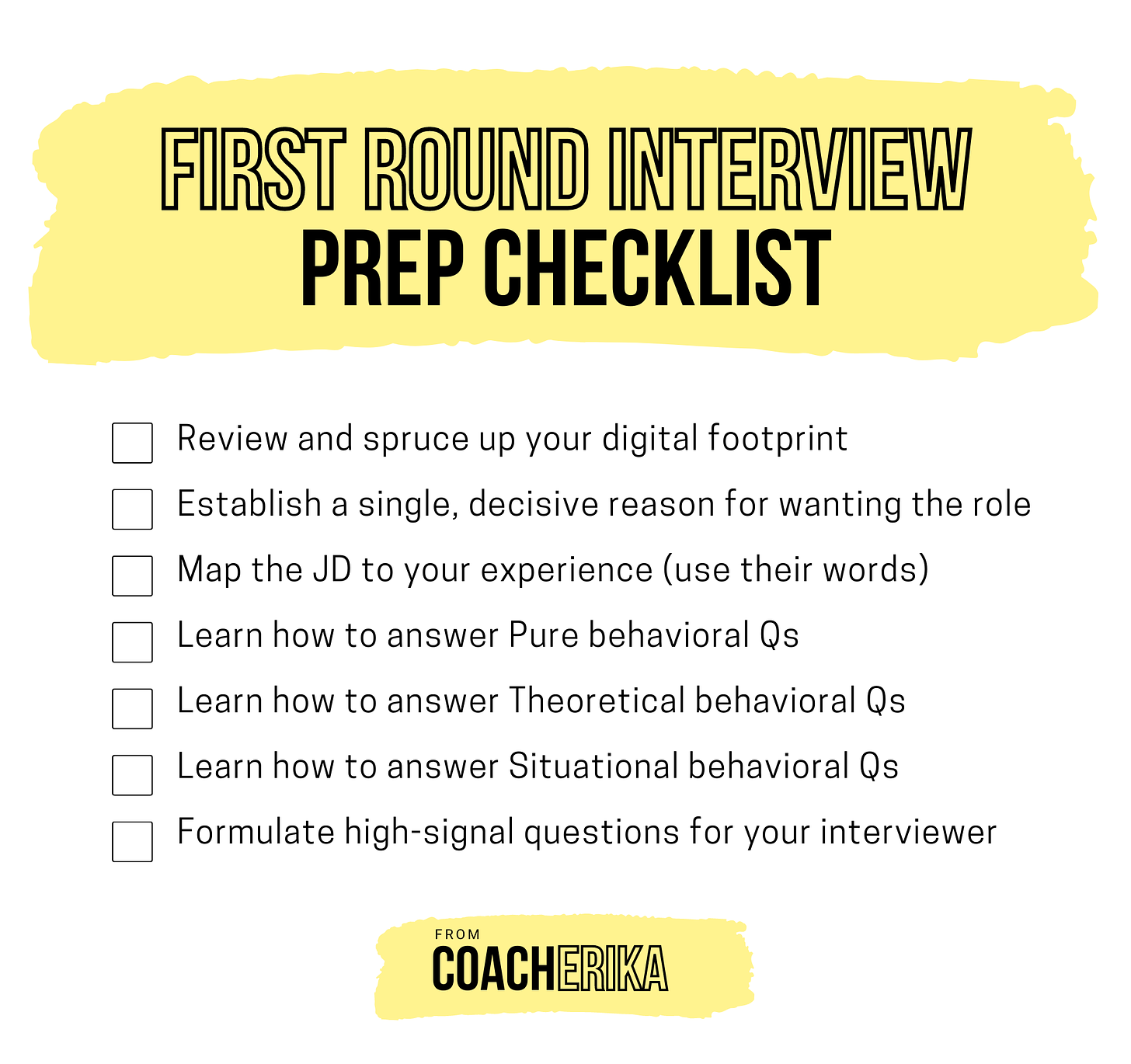
Some timing guidelines:
- Cleaning up your resume, LinkedIn, and online presence: 1-2 hours*
- Crafting a strategic, compelling career story: 1-1.5 hours
- Mining the job description: 30 minutes
- Walking down memory lane: 1-2 hours the first time; 30 minutes to refresh for any additional interviews
- Mastering behavioral questions: 4-6 hours*
- Formulating high-signal questions for interviewers: 1-2 hours
* A one-time task for your entire job search, not for every single interview
If you use MVIP, you can prepare for a first-round interview in three or four days (with about four hours per day of prep). If you’re working full-time, you can do it in a week with two to three hours a day. Much of what you learn with this MVIP interview prep system is reusable across interviews, so you will quickly see the effect of your preparation in later interviews.
Now you know how to prepare for and pass any first-round interview, even in a tough talent market. I’d love to hear your success stories using MVIP. Feel free to reach out at hello@coacherika.co.
That’s a wrap!
Further Study
Everything we discussed today is available in greater detail in my Substack, The Career Whispers. Useful deep-dive posts are linked below:
- Craft a Strategic and Compelling Career Story using The Career Whispers issue #001 here.
- Walk Down Memory Lane with The Career Whispers issue #002 here.
- Master Behavioral Interview Questions in The Career Whispers issue #003 here.
- Formulate G-R-R-REAT High-Signal Questions for Interviewers in The Career Whispers issue #004 here.
Thanks, Erika!
Have a fulfilling and productive week!


